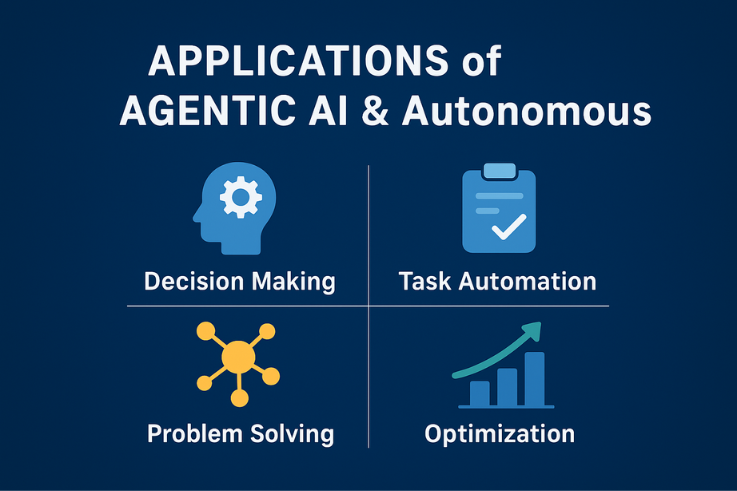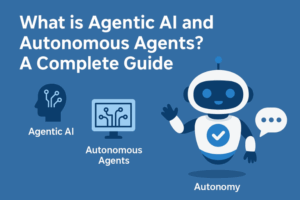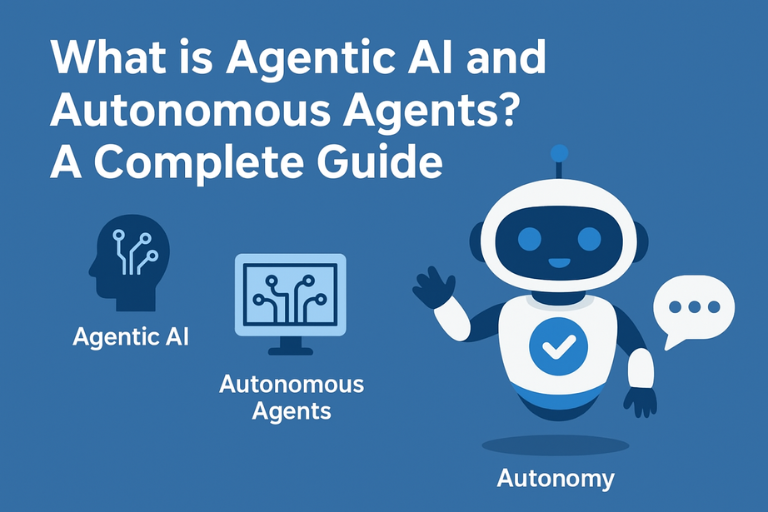Artificial Intelligence (AI) has evolved rapidly—from rule-based systems to large language models (LLMs) and generative AI. Now, in 2025, the spotlight is on the next frontier: Agentic AI and Autonomous Agents.
Unlike traditional AI, which responds passively to prompts, Agentic AI can act independently, make decisions, and pursue goals. This shift is set to transform how businesses, individuals, and machines interact.
But what exactly is Agentic AI? How do autonomous agents work? And why are they so important for the future of AI? Let’s break it down.
What is Agentic AI?
Agentic AI refers to artificial intelligence systems that exhibit agency—the ability to act independently, make decisions, and interact with the environment to achieve goals.
In simpler terms:
- Traditional AI → reactive (answers when asked).
- Agentic AI → proactive (takes initiative, plans, and executes tasks without constant input).
Key Features of Agentic AI:
- Autonomy: Can perform actions without explicit human instruction at every step.
- Goal-Oriented: Works towards objectives, not just outputs.
- Continuous Learning: Improves performance through feedback loops.
- Multi-Step Reasoning: Breaks down complex tasks into smaller actions.
- Collaboration: Can coordinate with humans or other AI agents.
Example: Instead of asking ChatGPT to book a flight, an Agentic AI travel assistant would:
- Search available flights.
- Compare prices.
- Book the ticket using stored preferences.
- Notify you once completed.
What are Autonomous Agents?
An autonomous agent is a software entity powered by AI that operates independently in an environment to complete tasks.
Think of it as a digital worker that:
- Observes its environment (inputs).
- Decides on actions (planning).
- Executes tasks (outputs).
- Learns from results (feedback).
Characteristics of Autonomous Agents:
- Independence: Runs with minimal supervision.
- Adaptability: Adjusts strategies based on changing conditions.
- Persistence: Works continuously until the goal is achieved.
- Embodiment: Can exist in software (bots) or hardware (robots).
Example:
- In e-commerce, an autonomous agent could manage inventory—predicting shortages, placing supplier orders, and updating stock levels automatically.
Agentic AI vs. Traditional AI
| Feature | Traditional AI | Agentic AI / Autonomous Agents |
|---|---|---|
| Nature | Reactive (responds to prompts) | Proactive (takes initiative) |
| Control | Human-driven at every step | Self-directed and goal-driven |
| Scope | Single-task focused | Multi-step, complex tasks |
| Learning | Static (needs retraining) | Dynamic (learns from feedback) |
| Use Case | Chatbots, recommendations | Auto-schedulers, AI workers |
How Do Autonomous Agents Work?
Autonomous agents rely on a loop of perception, reasoning, and action, often referred to as the Sense-Think-Act Cycle.
- Perception: The agent gathers data (e.g., text, images, sensor inputs).
- Planning/Reasoning: It decides the best course of action using AI models.
- Action/Execution: Performs the task (sending emails, booking, analyzing).
- Feedback Loop: Learns from results to refine future decisions.
Core Components:
- Large Language Models (LLMs): Provide reasoning and decision-making ability.
- Memory Systems: Store past experiences for context.
- Tool Integration: APIs, databases, and apps to take action.
- Multi-Agent Systems: Multiple agents collaborating on complex tasks.
Applications of Agentic AI & Autonomous Agents

1. Healthcare
- Virtual medical assistants schedule appointments and track patient health.
- Autonomous diagnostic systems analyze scans and prescribe next steps.
2. Finance
- Agents manage personal investments, execute trades, and detect fraud.
- Automated auditors ensure compliance in real-time.
3. Education
- AI tutors that adjust teaching pace based on student performance.
- Agents that grade assignments and provide feedback.
4. E-commerce & Retail
- Smart agents handle customer service, returns, and queries.
- Inventory agents forecast demand and automate restocking.
5. Manufacturing
- Autonomous robots optimize production lines.
- Maintenance agents predict equipment failures.
6. Transportation & Lagistics
- Delivery drones and self-driving cars act as physical agents.
- AI agents optimize fleet routes and reduce fuel costs.
7. Energy & Sustainability
- Smart grid agents balance energy supply and demand.
- Climate agents model environmental risks and recommend solutions.
8. Marketing & Sales
- Autonomous content creators draft blogs, emails, and social media posts.
- Lead-generation agents qualify prospects and send personalized offers.
Benefits of Agentic AI
- Efficiency: Handles multi-step tasks without constant oversight.
- Scalability: Can manage thousands of operations simultaneously.
- Accuracy: Reduces human errors in repetitive processes.
- Cost-Saving: Cuts workforce costs in routine tasks.
- Innovation: Opens possibilities like AI-run businesses and autonomous R&D.
Challenges of Agentic AI
- Ethical Risks: Agents may act in ways humans didn’t intend.
- Security Concerns: Autonomous actions raise cybersecurity risks.
- Over-Reliance: Humans may lose critical decision-making skills.
- Accountability: Hard to assign responsibility when AI acts independently.
- Bias & Fairness: Decisions reflect biases in training data.
The Future of Agentic AI and Autonomous Agents
- AI Co-Workers: Digital agents working alongside humans in offices.
- AI CEOs: Companies experimenting with autonomous decision-makers.
- Smart Cities: Traffic, energy, and security managed by AI agents.
- Personal AI Companions: Autonomous life managers for scheduling, health, and finances.
- AI Marketplaces: Autonomous agents buying/selling on behalf of users.
In short: Agentic AI isn’t replacing humans—it’s extending human capability.
FAQs
Q1: What is Agentic AI?
Ans: Agentic AI is artificial intelligence that can act independently, make decisions, and achieve goals without step-by-step human input.
Q2: What is an autonomous agent?
Ans: An autonomous agent is an AI-powered software or system that operates independently in an environment to complete tasks.
Q3: How does Agentic AI differ from traditional AI?
Ans: Traditional AI is reactive and task-specific, while Agentic AI is proactive, goal-driven, and capable of multi-step reasoning.
Q4: What are examples of Agentic AI?
Ans: AI travel assistants, autonomous trading bots, self-driving cars, and smart inventory managers.
Q5: What are the risks of autonomous agents?
Ans: Key risks include security threats, ethical misuse, bias in decisions, and lack of accountability.
Final Thoughts
Agentic AI and autonomous agents mark the next big leap in artificial intelligence. Instead of waiting for human instructions, these systems can think, plan, and act on their own.
From healthcare to finance, logistics to education, autonomous agents are already reshaping industries. But with these advancements come new challenges in ethics, governance, and security.
As we move into the future, success will depend not just on building powerful autonomous agents, but on ensuring they remain aligned with human values and societal good.

